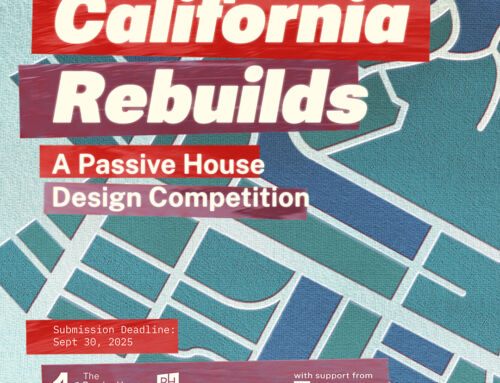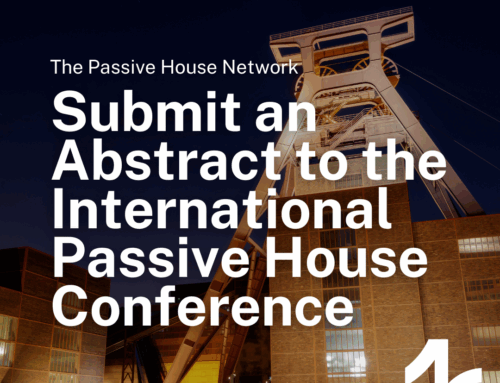
The Passive House Network Announces 2023 Design Awards Competition
The competition will recognize climate-specific innovation in project design and detailing to address the site’s particular needs, local climate, and bioregion.
Denver, CO, June 12, 2023 – The Passive House Network announced a new architectural design competition focused on climate-specific Passive House solutions for all climate zones across the US. The awards will celebrate deeply integrated design that provides the high-performance qualities of Passive House: comfort, health, resilience, and energy efficiency. Winning entries will demonstrate that making beautiful climate solutions today is possible.
“Passive House is adaptable to all climates and regions,” stated Andrew Michler, Committee Co-Chair and principal of Hyperlocal Workshop. “The awards are meant to celebrate achievement and raise awareness of what is possible.”
The awards will be based not on use type but on the 7 Passive House climate zones that span the US, with entries for new construction and retrofits. Of particular interest are the details and enclosure assemblies.
“We want beautiful buildings that are not just skin deep.” Says Bronwyn Barry, Principle of architecture firm Passive House BB and an Award Committee Co-Chair. “In a well-designed Passive House, the beauty extends to the detailing, the assemblies, the local climate responsiveness; it’s total architecture.”
The competition is being conducted in coordination with The Passive House Network’s annual national conference. Submissions are due Monday, September 4th, and the winners will be announced at the conference reception on October 4, in Denver, Colorado.
Prizes include stays at notable Passive House buildings: the MARtak cabin in the mountains of Colorado, and Hotel Marcel, the recently retrofitted Marcel Breuer building in Connecticut.
The jurors were selected from a range of perspectives and backgrounds, all with a keen appreciation for integrated architectural design and performance. The jurors are Lloyd Alter, Carbon Upfron!; Jessica Grove-Smith, Passive House Institute; Samantha Josaphat-Medina, Studio 397; Luis Medina, Studio 397; Marine Sanchez, RDH Building Science; Lindsay Schack, Love|Schack Architecture; and Brad Tomecek, Tomecek Studio Architecture.
Submitters can be from anywhere in the world, but the project locations must be located in the US, built, or in the design process.
“It is always gratifying to experience beautiful, high-performance Passive House buildings, tuned to their specific local requirements.” Remarked Jessica Grove-Smith, competition juror and Managing Director at the Passive House Institute. “Passive House is being successfully applied in all climate zones around the world, and it is important to celebrate these achievements.”
Find out more about the 2023 Design Competition here: https://passivehousenetwork.org/2023-phn-design-awards/
# # #
About PHN:
The Passive House Network (PHN), formerly known as NAPHN, is a 501(c)3 that provides Passive House high-performance building education and resources to professionals across the U.S. that transform how they think and work with buildings. PHN provides professionals a complete skill set to reliably produce new and renovated buildings that use dramatically less energy for effective and affordable climate action. https://passivehousenetwork.org/
About PHI:
The Passive House Institute (PHI) is an independent research institute that has played an especially crucial role in the development of the Passive House concept – the only internationally recognized, performance-based energy standard in construction. https://passivehouse.com/
About Passive House:
Passive House is an international building standard and methodology, applicable to buildings of all kinds, from office buildings to hospitals, new-build, and renovations, that results in a dramatic drop in operational energy use and more comfortable and healthy occupants – meant to mitigate our climate crisis while providing resilient adaptation aggressively.
The Passive House Standard was developed by the Passive House Institute (PHI), an independent scientific research organization located in Darmstadt, Germany, and includes specific requirements for energy use and the comfort of occupants. The Passive House Standard is being successfully applied to thousands of buildings and millions of square feet around the world, from Boston to Beijing.
The Passive House methodology starts with reducing cooling, dehumidification, and heating loads by focusing not on gadgets and active technology but instead on fully integrated durable passive building components, such as proper continuous thermal-bridge-free insulation, continuous airtightness, high-performance windows and doors, and ventilation that includes a high-efficiency heat/energy recovery core, carefully calculated, and all integrated with the entire architectural process of design and construction. http://www.passivehouse.com http://www.passipedia.org
The International Passive House Association is a membership, communications, and global community-building arm of the Passive House Institute with over 30 affiliated regional Passive House organizations worldwide. https://passivehouse-international.org/




